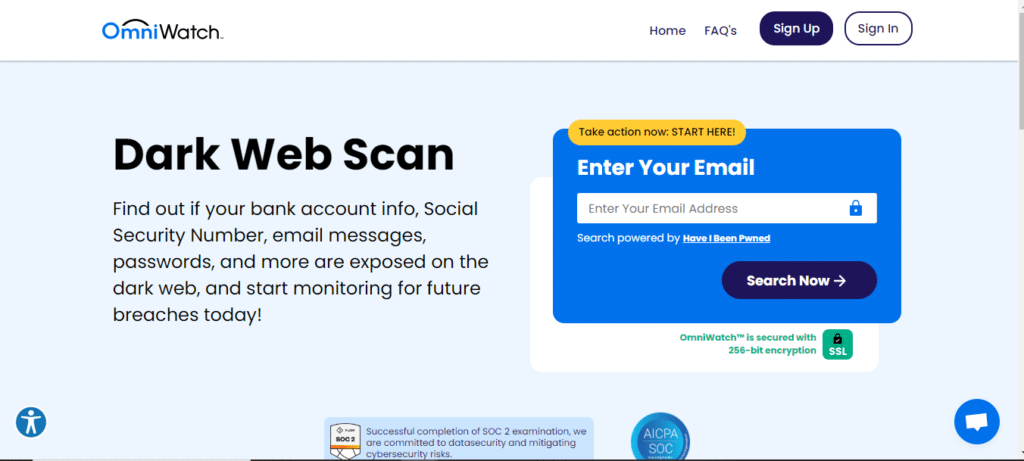The term “Dark Web” often brings to mind secretive online activities and mysteries related to the internet. It’s a place that remains unknown to many of us, and yet, it has a sizeable effect on our non-public protection. According to the latest 2022 survey, while 8% of U.S. Adults are entirely unaware of the dark web, approximately 23% have heard of it but don’t, in reality, understand what it entails.

This gap is alarming, particularly when researchers discover over 1.5 million stolen credit score card info from the U.S. is being bought on this hidden part of the internet.
But how does such sensitive information end up on the dark web when most people do not even recognize how to access it?
The solution lies in various cyber threats that might be becoming all too common: records breaches, state-of-the-art scams, and relentless cyber assaults ranging from phishing schemes to malware infections and even virtual identity theft. It’s a lot to take in, and it is comprehensible to feel a bit overwhelmed.
In this blog, we’re going to shed some light on the dark internet and offer realistic, actionable guidelines that will help you and your circle of relatives live safe from information breaches and other digital risks. Whether you’re a tech-savvy youngster or just curious about protecting your online presence, this guide is customized to assist everybody who wants to navigate the internet in an easy and approachable way.
Difference Between Dark Web Deep Web and visible web
The web is regularly visualized as an iceberg, divided into layers primarily based on accessibility and visibility. The topmost layer, the visible web, is what most of us use daily and is without difficulty on hand.
Beneath this layer lies the deep net, a mile-larger segment of the internet that is not listed by general search engines like Google and is used generally for steady communications and information garages. Below the deep net is the dark net, a smaller portion regarded for its anonymity but frequently related to illicit activities.
Get an Instant Cyber Background Check
Prepare to Be Shocked! Search Any Name to Begin.
Comparison Table
| Attribute | Visible Web (Surface Web) | Deep Web | Dark Web |
| Accessibility | Accessed through common browsers; indexed by mainstream search engines. | Requires special credentials or URLs; hidden from mainstream search engines. | Accessible only via special software like Tor; completely hidden from mainstream search engines. |
| Content Types | Public sites for news, blogs, social media, and e-commerce. | Secure databases, confidential corporate information, private academic and medical records. | Illegal marketplaces, whistleblower sites, privacy-focused forums. |
| Percentage of the Internet | About 4-10% of the internet’s content. | Approximately 90% of the internet’s content, mostly hidden. | Less than 1% of the total internet, often exaggerated in perceived size. |
| Main Uses | General public use for information, shopping, entertainment, and social networking. | Used by professionals for confidential and proprietary activities, data storage. | Used for activities requiring high levels of anonymity and privacy, both legal and illegal. |
| User Identity | User identity easily traceable through various digital footprints. | Users maintain high anonymity and identity protection through encryption and routing techniques. | User identity is easily traceable through various digital footprints. |
| Security Level | Variable; generally lower due to high accessibility and visibility. | High due to access restrictions and lack of public indexing. | Very high; emphasizes encryption and anonymity, though also attracts illegal activities. |
| Legal Monitoring | Highly monitored by law enforcement and government agencies. | Monitored through legal channels as necessary; generally secure from public view. | Heavily targeted by law enforcement agencies for illegal activities, though tracking is challenging. |
| Common Technologies Used | HTML, CSS, JavaScript; relies on standard web protocols and search engine algorithms. | Encryption, VPNs, firewalls, secure authentication protocols. | Tor, PGP encryption, cryptocurrency platforms for anonymous transactions. |
| Typical Users | Wide public usage across all demographics for daily activities. | Professionals in various fields requiring confidentiality and security. | Activists, privacy advocates, and those engaged in illegal activities. |
| Gender Distribution | About 50% male and 50% female across general websites, with variations by site type. | Skews slightly more male, especially in tech-heavy fields and forums. | Predominantly male, estimated at 84.70%, particularly in technology and illegal activity forums. |
| Usage Statistics | Billions of users daily; over 4.5 billion people have internet access. | Hundreds of millions use it for banking, healthcare, and academia, though specific numbers are hard to pinpoint due to privacy. | Estimated 2.5 million daily visitors specific active user numbers are challenging to track due to anonymity. |
| Examples | Google, YouTube, Facebook, Amazon. | Private company intranets, online banking, academic journals, medical records systems. | Silk Road (defunct), hidden political discussion forums, and marketplaces for illicit goods. |
Types of Dark Web Networks Available
The dark web is like a hidden internet layer inaccessible through regular browsers. It’s a place where anonymity is key, and people can communicate or browse without leaving a trace.
Despite its relative obscurity, the dark web fascinates and alarms with its promise of anonymity and its association with illicit activities. In 2023 alone, the dark web attracted an average of 2.5 million visitors daily, which grew to 2.7 million by April. This surge in traffic highlights the growing interest and use of this hidden internet sector.
Common browsers for Accessing the Dark Web:
Tor Browser:
Imagine a special browser that helps you visit websites privately and securely. Tor Browser does just that by sending your internet connection through several layers, like wrapping your data in multip 678le blankets to keep it safe from prying eyes. This makes it the main door to the dark web and its hidden services.
DuckDuckGo:
This is a search engine that respects your privacy. Unlike other search engines, DuckDuckGo doesn’t keep track of what you search for, making it a popular choice for users on the dark web who prioritize privacy.
Freenet:
Think of Freenet as a secret club where everyone can share their thoughts or publish things without worrying about censorship. It’s a network where users connect directly with each other, skipping central servers, so everything remains between users only.
Tails:
This is a portable operating system that you can run from a USB stick or a DVD. It’s designed to keep your activities private and not leave any traces on your computer.
Community Hubs and Forums:
| Forum | Description | Uses |
| The Hub | A forum for discussions on darknet marketplaces and related news, acting as a central gathering place. | Sharing and receiving updates on darknet marketplace activities. |
| Dread | A Reddit-like platform on the dark web for discussions related to darknet markets and privacy issues. | Community discussions on privacy and darknet market insights. |
| CryptBB | A forum catering to the elite of the cybercriminal community, offering high-level discussions on cyber threats. | Advanced discussions on hacking techniques and cyber threats. |
| Free Hacks | A Russian-based forum started in 2014, providing access to various hacking tools and resources. | Learning and accessing hacking tools and information on cybercrime. |
How did personal information get on the dark web?
When you hear about personal information being bought on the dark web, it might appear like something from a thriller film. However, it’s a reality that impacts millions of humans globally.
The dark internet is a hidden market where cybercriminals alternate stolen records for money. Understanding how private records are received on the dark web is critical for shielding yourself. Here’s a simplified clarification: Here’s a simplified explanation:

Types of Data and Goods Available on Dark Web Marketplaces:
- Stolen Personal Information: This includes sensitive details like credit card numbers, bank account information, IP addresses, and personal identification data.
- Compromised Accounts: Cybercriminals can gain access to and sell login details for various online accounts, such as email, social media platforms, and streaming or gaming services.
- Forged Documents: These can range from passports to driver’s licenses to university degrees.
How Your Data Ends Up on the Dark Web
The following is how your personal information ends up online without your knowledge.
Data Breaches
Data breaches are the most common way for non-public records to end up on the dark web. For instance, in January 2024, Russian hackers successfully assaulted Microsoft, using a method called credential stuffing to access and steal sensitive data and statistics.
That same month, Australia witnessed its largest government cyberattack, with sixty-five departments and companies infiltrated, compromising 2.5 million files. These incidents show how massive-scale breaches can expose large amounts of touchy information and doubtlessly sell it on the dark net.
Phishing Attacks and Global Espionage
Phishing assaults are another common approach used by cybercriminals. In November 2023, suspected Chinese hackers released large espionage campaigns focused on numerous countries, including Uzbekistan, the Republic of Korea, Japan, and others. They utilized phishing schemes and exploited security weaknesses to thieve facts, which could be used in addition to crook sports or sold on the dark internet.
Malware and Spyware
Software like malware and spyware can capture and transmit personal data without the user’s knowledge. These tools are designed to infiltrate devices and steal information ranging from keystrokes to sensitive personal files, which are then trafficked on the dark web.
Unsecure and Public Wi-Fi Networks
Unsecure Wi-Fi networks provide an easy opportunity for cybercriminals to intercept personal information. Any sensitive data transmitted over these networks may be captured and could be sold on the dark web.
Insider Threats
Sometimes the danger comes from within an organization. This could be an employee misusing their access to sensitive data and selling it on the dark web for personal profit.
Accidental Exposure
Not all information on the dark web is there due to malicious activity. Sometimes, data is accidentally exposed online through unsecured databases or poor network configurations. Though not stolen, cybercriminals scanning for such leaks can still harvest this data.
Notable Cyberattacks and Sanctions
Recent cyber incidents underscore the gravity of these threats. In January 2024, the Australian government took a historic step by sanctioning Russian hacker Aleksandr Ermakov for his role in the 2022 Medibank breach, which affected 9.7 million people. This marked Australia’s first cyber sanction against an individual, highlighting the international efforts to combat such crimes.
How to Remove Your Information from the Dark Web
Finding your personal information on the dark web can be alarming. The dark web is notorious for being a hidden marketplace where stolen data, such as personal identities, financial details, and login credentials, are bought and sold. If your information has made its way there, acting swiftly to mitigate potential damages is crucial. Here’s a step-by-step guide on how to approach this challenging situation:
Step 1: Confirm the Breach
Before taking any action, ensure your information is on the dark web. Sometimes, notifications from monitoring services can be false alarms. Use a credible service to check whether your data is being traded on the dark web. Many cybersecurity firms offer dark web scanning services that can confirm any data leakage.

Step 2: Determine the Scope of the Exposure
Understand exactly what information is exposed. Is it your email, password, social security number, or more sensitive financial details? Knowing the scope of the exposure helps in planning the appropriate response to secure your accounts and identity.
Step 3: Change Your Passwords
Immediately change the passwords for all affected accounts, and consider updating passwords for other critical accounts as a precaution. Use strong, unique passwords for each account to minimize the risk of multiple accounts being compromised from a single breach.
Step 4: Alert Affected Institutions
Contact the financial institutions involved if the exposed information includes financial details such as credit card numbers or bank account information. Inform them about the breach so they can watch for suspicious activity and potentially freeze your accounts to prevent unauthorized access.
Step 5: Consider Identity Theft Protection Services
Enroll in an identity theft protection service. These services monitor the use of your personal information and alert you to potential misuse. They can also assist in recovering your identity if theft occurs and often offer insurance to cover related losses.
Step 6: Report to Authorities
Report the breach to the appropriate authorities. These entities can provide further guidance and help mitigate the damage. Following are government agencies you can report to
- The Internet Crime Complaint Center (IC3)
- Federal Bureau of Investigation (FBI)
- Federal Trade Commission (FTC)
- Cybersecurity and Infrastructure Security Agency (CISA)
- Cyber Safety Review Board (CSRB)
Step 7: Continuous Monitoring
After securing your accounts and reporting the incident, monitor your financial statements and credit reports regularly.
How to Protect Yourself and Your Family from this Threat
Here are practical steps to enhance your family’s cybersecurity:
- Educate on Online Safety: Teach family members about the dangers of oversharing personal information and how to recognize phishing scams.
- Use Strong Passwords: Create complex passwords for every account, using a mix of characters, and consider a password manager to store them securely.
- Activate Two-Factor Authentication: Add an extra security layer by enabling two-factor authentication on important accounts.
- Install Security Software: Protect devices with updated antivirus and anti-malware software, and regularly update operating systems and apps.
- Manage Privacy Settings: Regularly check and adjust social media privacy settings to minimize public exposure of personal details.
- Secure Your Wi-Fi: Use strong passwords and the latest encryption (WPA2 or WPA3) on your home network, and set up a guest network for visitors.
- Monitor Financial Accounts: Routinely check bank and credit card statements and credit reports for signs of unauthorized activity.
- Use VPNs on Public Wi-Fi: If you must use public Wi-Fi, ensure your connection is encrypted by using a VPN.
- Be Careful with Links and Downloads: Avoid clicking on suspicious links or downloading files from untrusted sources to prevent malware infections.
- Keep Sensitive Info Confidential: Stress the importance of keeping personal details like Social Security numbers and account passwords private.
Final Words:
Navigating the digital world safely is crucial for protecting our personal information and our peace of mind. By implementing the strategies outlined in this blog, you can create a robust defense against online cyber threats. Remember, cybersecurity is not a one-time setup but a continuous process of education, vigilance, and adaptation to new challenges.
Encourage your family to stay informed about cybersecurity trends and best practices. Open conversations about online safety can empower each family member to take proactive steps toward securing their digital footprint. With the right tools and a vigilant mindset, you can enjoy the benefits of the internet without falling prey to its potential pitfalls.
Reverse Email Search
You may see their name, age, photos, phone numbers and social media profiles.
